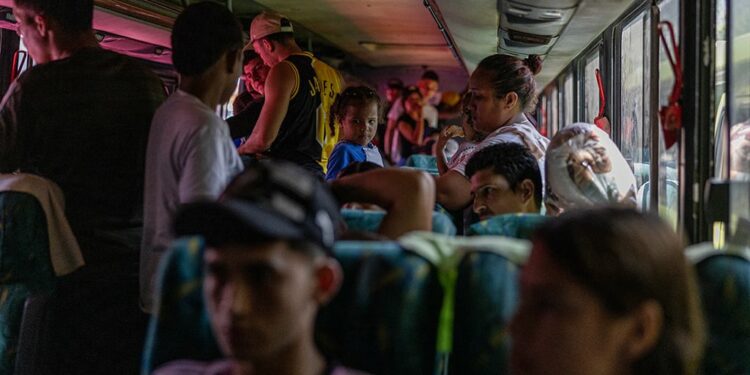PASO CANOAS, Costa Rica – Migrant advocates in this small town on the Panama-Costa Rica border say their country has become the United States’ “tercera frontera” – its third border – a place where the U.S. hopes to slow migrants from continuing north.
The Costa Rican government, however, has implemented a busing system that actually speeds migrants northward, while relatively few are able to enroll in a system designed by the U.S. government to stem the flow of people headed to the U.S. border.
In 2023, the U.S. tapped Costa Rica and three other countries – Guatemala, Colombia and Ecuador – for new “Safe Mobility” offices. Migrants can apply for “refugee resettlement” in the United States or elsewhere, without having to travel to the U.S. border to seek asylum. Migrants are also provided information about other legal migration pathways. The program uses an innovative online system for submitting and tracking applications.
During the administration of President Joe Biden, 22 % of asylum applications have been approved, but 77 % of applicants have remained in the United States, whether approved or not. Only a small fraction of applicants end up being deported if their application is denied. Proponents of the Safe Mobility offices say the system could reduce the number of undocumented immigrants in the U.S. and the flow of migrants to the southern border, while keeping more migrants safe from the dangers of traveling through multiple countries.
In Costa Rica, the Safe Mobility program is managed by the U.S. State Department, the United Nations High Commissioner for Refugees (UNHCR) and the International Organization for Migration (IOM).
A September 2024 report from the Mixed Migration Centre said, “despite their flaws, the Offices offer a new path to protection in an environment where such things are rare.”
But one of the program’s major shortcomings, according to the report, is the low number of migrants who attempt to use it. That’s due to low recruitment levels and the limited nature of legal migration pathways to the United States.
“While the SMOs have been successful in resettling thousands of refugees and are generally seen as a positive initiative, the study finds they so far have limited influence on the number of people traveling along dangerous migration routes in the region,” the Mixed Migration Centre said in a press release.
A representative with the U.S. Embassy in Costa Rica said as of this February, the office had facilitated 10,400 claims, a small fraction of the almost half a million migrants and refugees the UNHCR said made their way through Costa Rica in 2023 with the goal of reaching the U.S.
“We have a very close and cooperative relationship with Costa Rica – they’re a strong partner,” said a State Department official at the U.S. embassy in Costa Rica.
But the Safe Mobility program apparently isn’t well-known, even at high levels of the Costa Rican government.
“I haven’t heard of it,” said Stephan Brunner, one of Costa Rica’s two vice presidents, in an interview with the Cronkite Borderlands Project.
In fact, in contrast to the goals of the Safe Mobility program, the Costa Rican government is operating a system that speeds migrants northward.
Brunner said the heavy flow of migrants passing through Costa Rica prompted President Rodrigo Chaves to declare a state of emergency in September 2023.
Weeks later, Costa Rica and Panama agreed upon a plan to quickly bus migrants through the two countries. Panama receives migrants who enter its southern border from Colombia, after crossing the dangerous Darién Gap, and buses them north to Costa Rica, which, in turn, buses the migrants north to Nicaragua.
Source link : http://www.bing.com/news/apiclick.aspx?ref=FexRss&aid=&tid=671057c61fe64d7eac26bb9c72dcd75e&url=https%3A%2F%2Fcronkitenews.azpbs.org%2F2024%2F10%2F16%2Fcosta-rica-safe-mobility-program-asylum-seekers-refugees-migrants%2F&c=2783305164836839439&mkt=en-us
Author :
Publish date : 2024-10-16 12:20:00
Copyright for syndicated content belongs to the linked Source.






